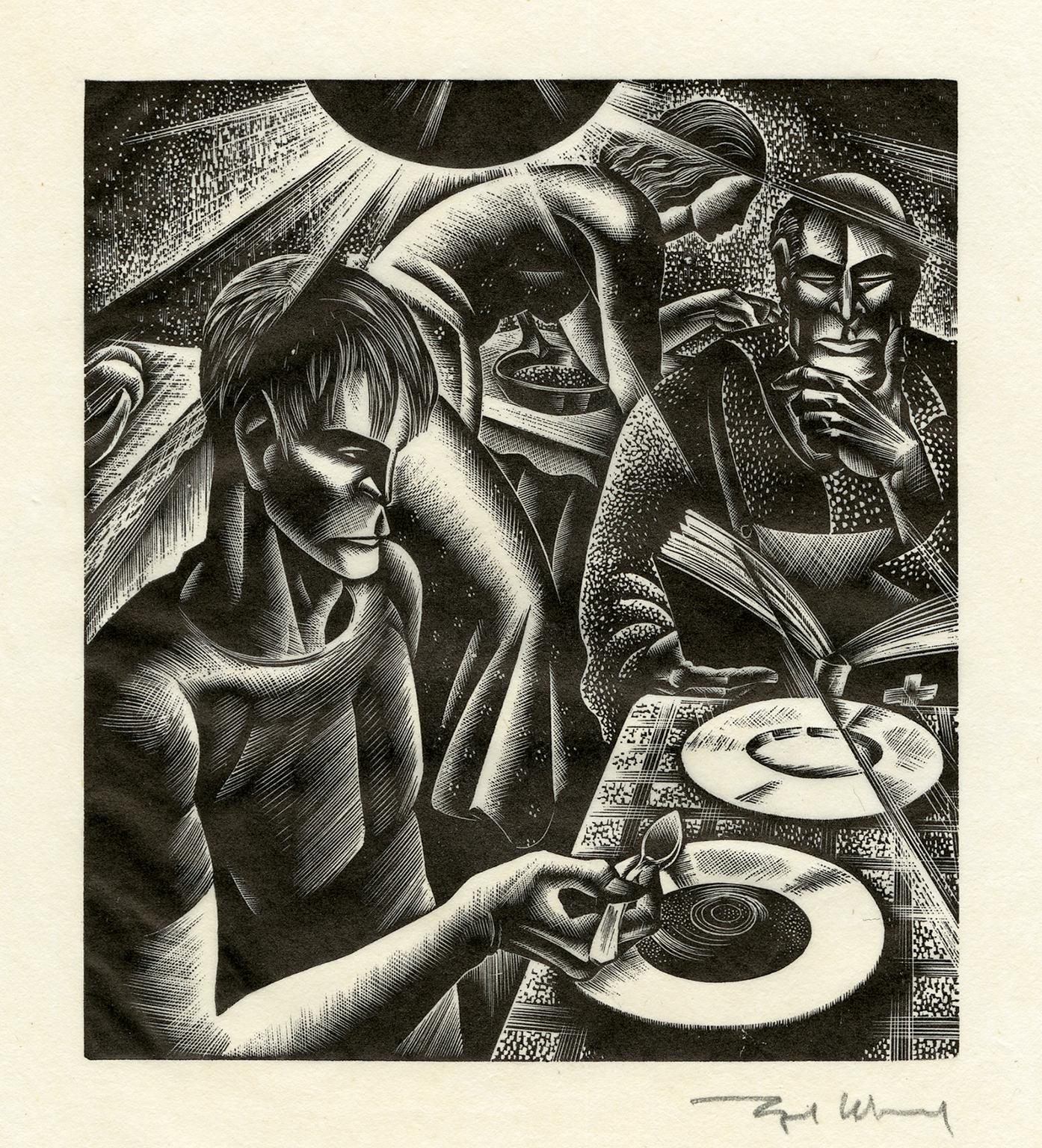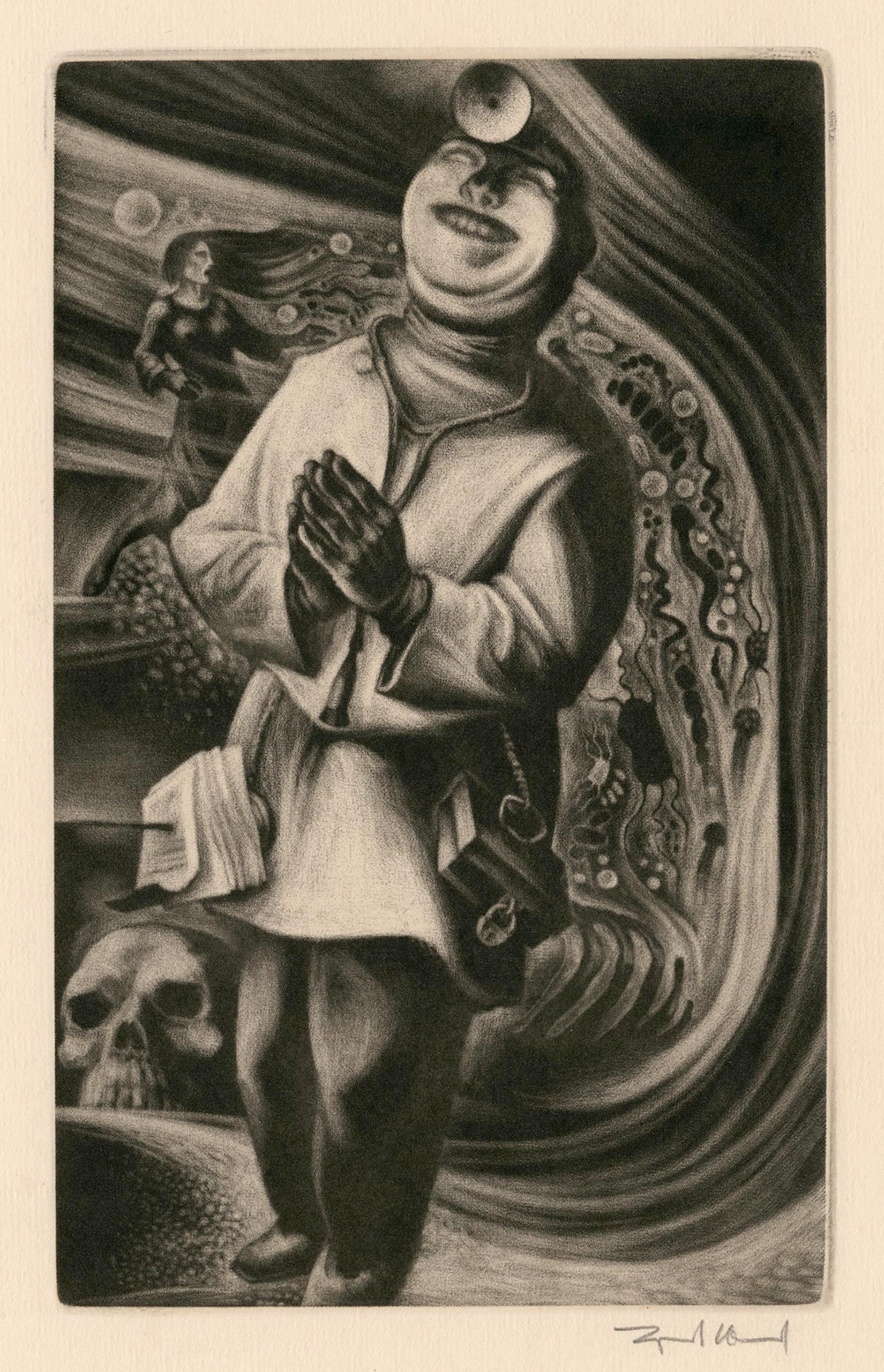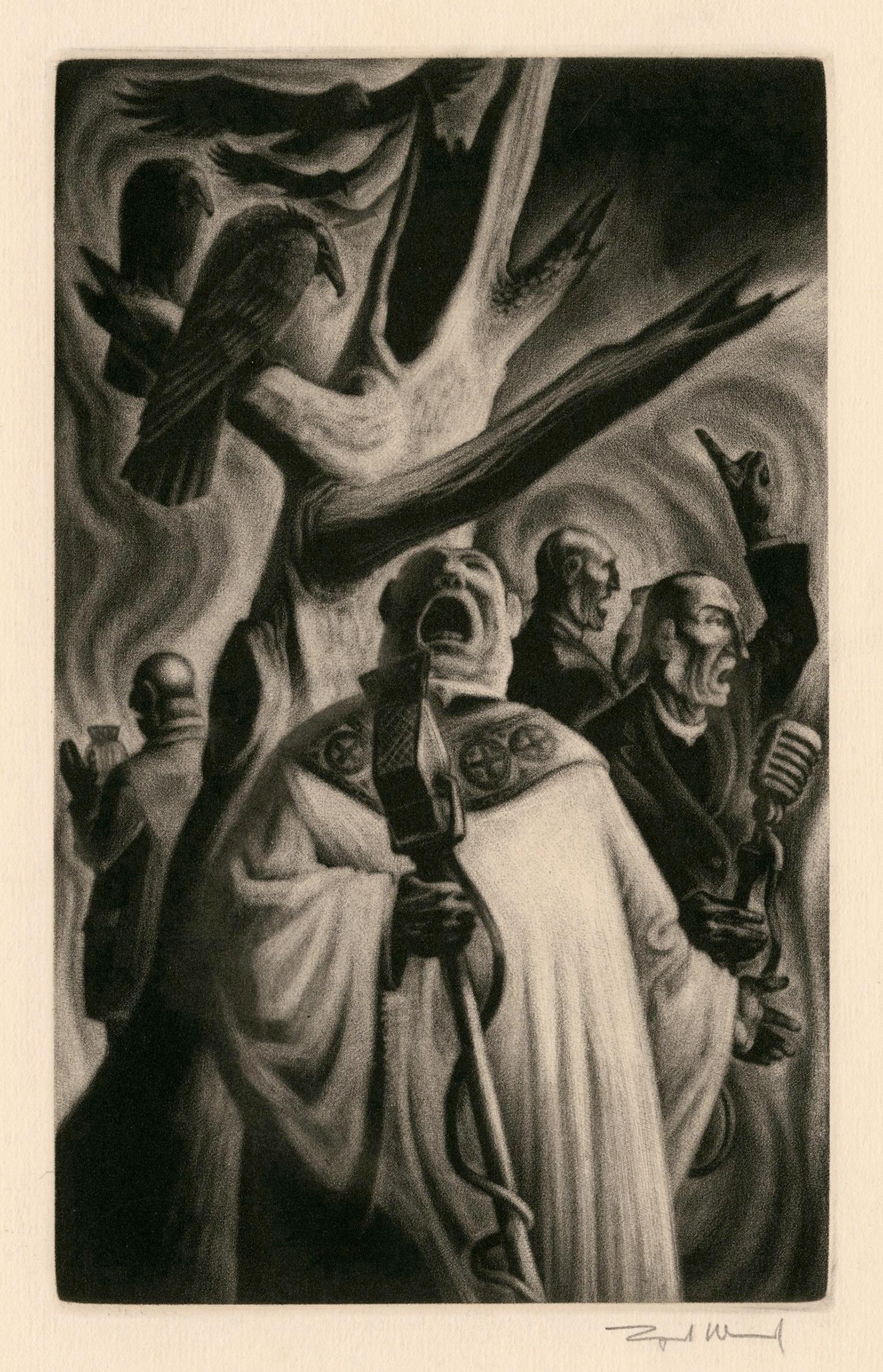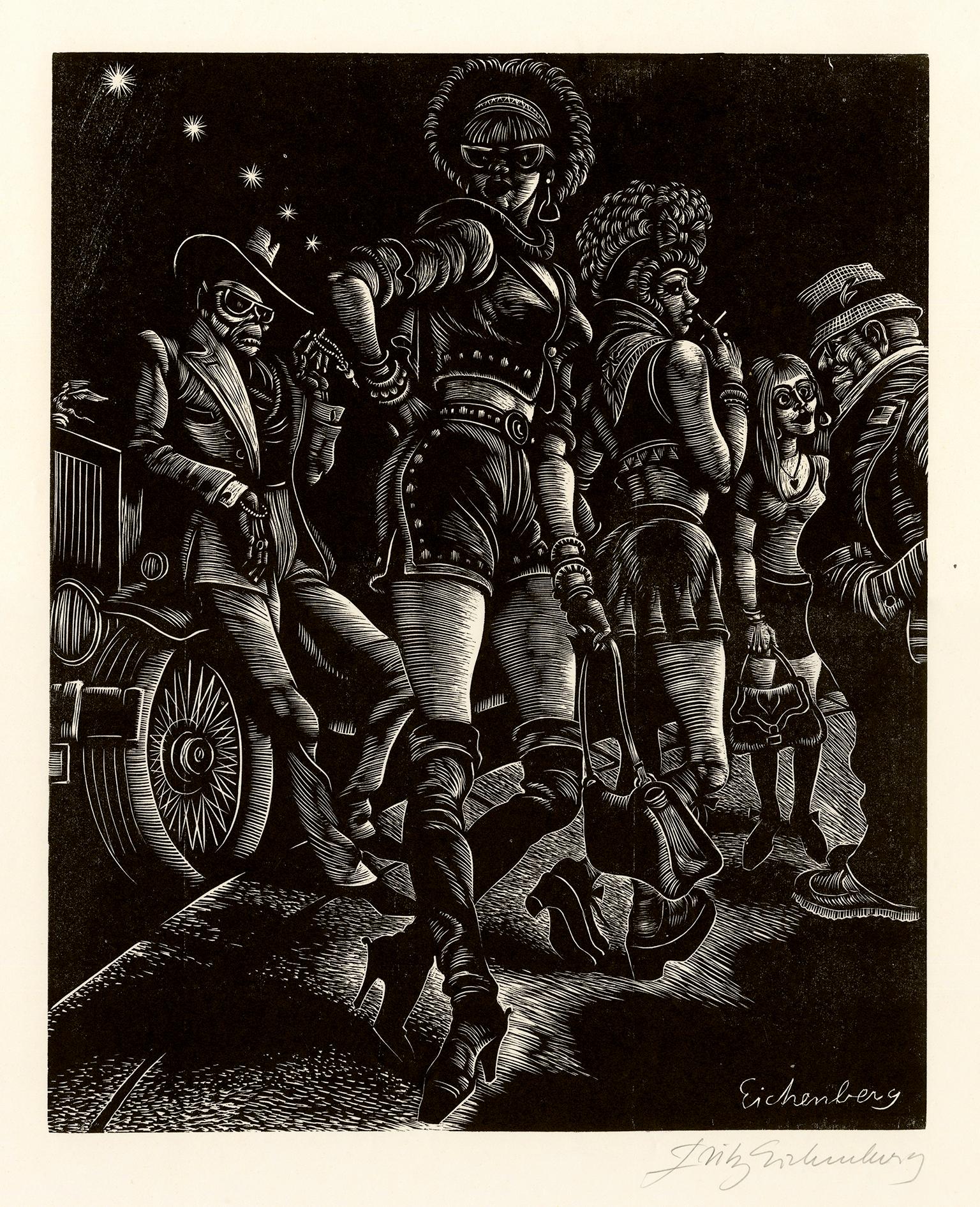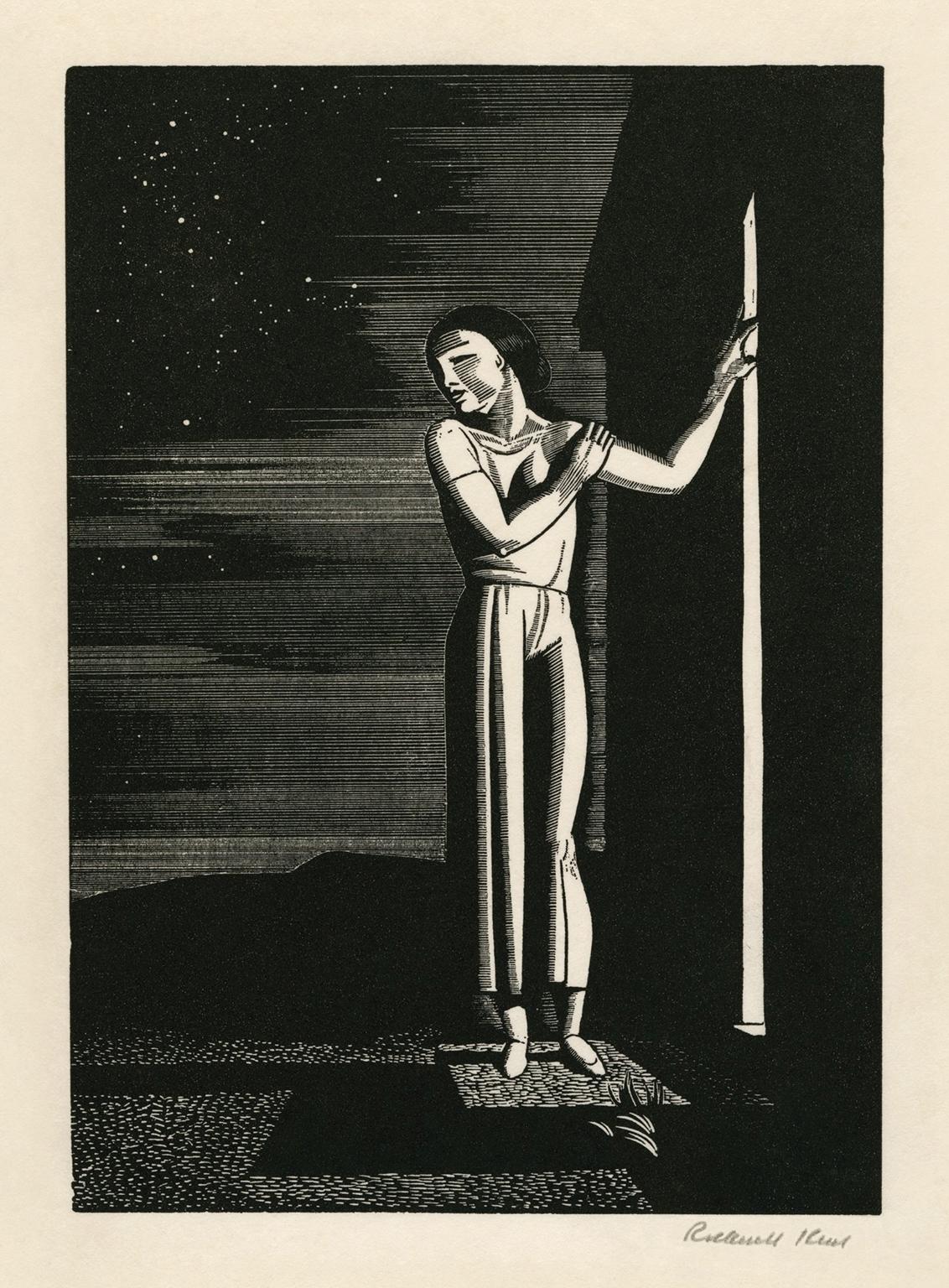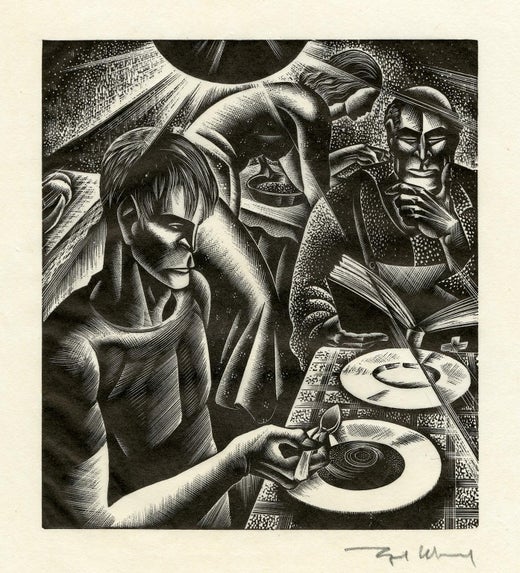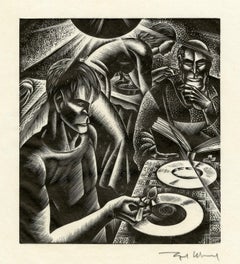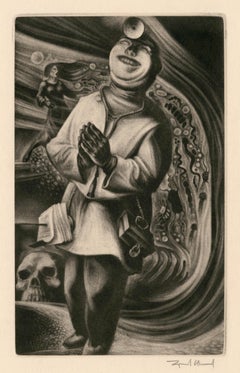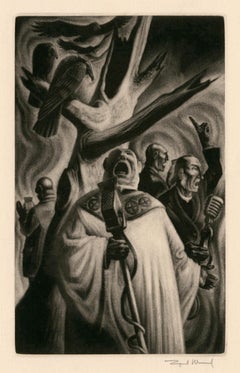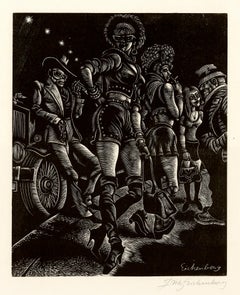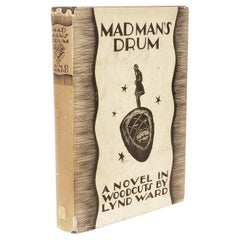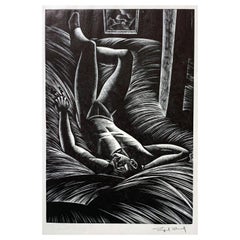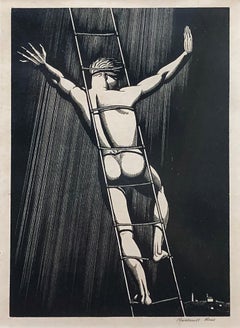Items Similar to Madman's Drum (Brothel) — 'Story Without Words' Graphic Modernism
Want more images or videos?
Request additional images or videos from the seller
1 of 3
Lynd WardMadman's Drum (Brothel) — 'Story Without Words' Graphic Modernism1930
1930
$650
£487.37
€565.03
CA$907.11
A$1,013.16
CHF 526.47
MX$12,338.23
NOK 6,687.32
SEK 6,301.38
DKK 4,215.82
Shipping
Retrieving quote...The 1stDibs Promise:
Authenticity Guarantee,
Money-Back Guarantee,
24-Hour Cancellation
About the Item
Lynd Ward, 'Madman's Drum, Plate 41', wood engraving, 1930, edition small. Signed in pencil. A fine, richly-inked impression, on off-white tissue-thin Japan paper; the full sheet with margins (1 5/8 to 2 1/2 inches); a small paper blemish in the upper right margin, away from the image, otherwise in excellent condition. A scarce, artist-printed, hand-signed proof impression before the published edition. Matted to museum standards, unframed.
Image size 5 1/2 x 3 3/4 inches (140 x 95 mm); sheet size 9 5/8 x 7 1/8 inches (244 x 181 mm).
From Lynd Ward’s book of illustrations without words, 'Madman’s Drum', Jonathan Cape and Harrison Smith, New York, 1930.
Reproduced in 'Storyteller Without Words, the Wood Engravings of Lynd Ward', Harry N. Abrams, New York, 1974.
ABOUT THE ARTIST
Lynd Ward is acknowledged as one of America’s foremost wood engravers and book illustrators of the first half of the twentieth century. His innovative use of narrative printmaking as a stand-alone storytelling vehicle was uniquely successful in reaching a broad audience. The powerful psychological intensity of his work, celebrated for its dynamic design, technical precision, and compelling dramatic content, finds resonance in the literature of Poe, Melville, and Hawthorne. Like these classic American writers, Ward was concerned with the themes of man’s inner struggles and the role of the subconscious in determining his destiny. An artist of social conscience during the Great Depression and World War II, he infused his graphic images with his unique brand of social realism, deftly portraying the problems that challenged the ideals of American society.
The son of a Methodist preacher, Lynd Ward, moved from Chicago to Massachusetts at an early age. He graduated from the Teachers College of Columbia University, New York, in 1926, where he studied illustration and graphic arts. He married May Yonge McNeer in 1936 and left for Europe for their honeymoon in Eastern Europe. After four months, they settled in Leipzig, where Ward studied at the National Academy of Graphic Arts and Bookmaking. Inspired by Belgian expressionist artist Frans Masereel's graphic novel ‘The Sun,’ and another graphic novel by the German artist Otto Nückel, ‘Destiny,’ he determined to create his own "wordless" novel. Upon his return to America, Ward completed his first book, ‘God's Man: A Novel in Woodcuts,’ published in 1929. ‘Gods’ Man’ was a great success for its author and publisher and was reprinted four times in 1930, including a British edition. This book and several which followed it, ‘Madman’s Drum,’ 1930, ‘Wild Pilgrimage,’ 1932, ‘Prelude to a Million Years,’ 1933, ‘Song Without Words,' 1936, ‘Vertigo,’ 1937; and ‘Last Unfinished Wordless Novel’ (created in the 1960s and published in 2001) were comprised solely of Ward's wood engravings. Ward designed each graphic image to occupy an entire page, the sequence of which conveys the story's narrative.
In 1937, Ward was named Director of the Graphic Arts Division of the Federal Art Project, a division of the Works Progress Administration (WPA). In the following years, Ward went on to illustrate more than one hundred books (some of which he wrote), including classics for the Limited Editions Club Goethe’s ‘Faust,’ Faulkner’s ‘A Green Bough,’ and Mary Shelley’s ‘Frankenstein,’ and several children’s books. He also produced single-subject wood engravings, paintings, and drawings. His print ‘Sanctuary,’ 1939, was shown at the 1939 New York World’s Fair, and ‘Clouded Over,’ 1948, received the 1948 Library of Congress Award and was included in ‘American Prize Prints of the 20th Century’ by Albert Reese. He received the National Academy of Design Print Award (1949), the New York Times Best Illustrated Award (1973), and the Regina Award (Catholic Library Association, 1975). ‘The Biggest Bear,’ a children’s book with illustrations by Ward, was the recipient of the esteemed 1952 Caldecott Medal of the American Library Association.
An Honorary Fellow of the Royal Society of Painter-Etchers and Engravers, Ward was a member and board member of the National Academy of Design and the Artists’ League of America. He served several terms as president of the Society of American Graphic Artists and was a member of the American Artists Congress and the Society of Illustrators. Ward exhibited at the American Artists Congress; the National Academy of Design; the John Herron Art Institute; and the Library of Congress. He had a one-person show at Associated American Artists, NY, on the publication of his monograph 'Storyteller Without Words,' 1974; AAA mounted a memorial exhibition in 1986. The May 1976 issue of 'Bibliognost,' a book collector’s publication, was dedicated to Ward. ‘Lynd Ward, His Bookplate Designs,’ an article by Dan Burne Jones, was published in the American Society of Bookplate Collectors and Designers Yearbook, 1981/82.
In 2001, sixteen years after his death, Rutgers University Libraries published ’Lynd Ward’s Last Unfinished Wordless Novel.’ The blocks were intended to be part of a novel in woodcuts, the first since Vertigo, but Ward did not live to complete the project. Master printer and book designer Barbara Henry collated and printed the twenty-six finished blocks out of the forty-four initially planned for the still unnamed narrative.
In 2010 the Library of America honored Ward’s achievements with the meticulous production of a collection of Ward’s woodcut novels—the first time the Library had gone wordless. The publication replicated his original editions with a single full-size image printed on the right page of each double-page spread. In his introduction to the books, renowned cartoonist/illustrator Art Spiegelman comments, “Ward had a genius for caving human movement, and watching his characters walk through their storylines is a particular joy of his novels. You see a very tightly woven narrative that rewards contemplation and a revisiting of how it’s told as well as what’s being told. Each of his books teaches itself. As you’re reading, you understand better how to read each book—the speech and rhythms of what one can find as one revisits a picture. The whole point of Ward’s work is to make you look and understand.”
The Grolier Club in New York mounted a one-person exhibition of Ward’s work from November 19, 2015, through January 16, 2016, displaying the wide range of his graphic accomplishments in woodcuts, lithography and mezzotint, brush drawings, line drawings, watercolors, and paintings.
An extensive archive of work by Lynd Ward is in the Georgetown University Art Collection, Washington, DC. Among the many other public collections representing his work is the Baltimore Museum of Art, British Museum, Cleveland Museum of Art, Farnsworth Art Museum, Fine Arts Museums of San Francisco, Georgetown University, Library of Congress, McNay Art Museum, Newark Museum, New York Public Library, Metropolitan Museum of Art, Museum of Modern Art, Pennsylvania Academy of the Fine Arts, Pennsylvania State University, Philadelphia Museum of Art, Rhode Island School of Design, Smithsonian American Art Museum, University of Chicago, and the Zimmerli Art Museum (Rutgers University).
- Creator:Lynd Ward (1905 - 1985, American)
- Creation Year:1930
- Dimensions:Height: 5.07 in (12.88 cm)Width: 3 in (7.62 cm)Depth: 0.01 in (0.26 mm)
- Medium:
- Movement & Style:
- Period:
- Condition:
- Gallery Location:Myrtle Beach, SC
- Reference Number:Seller: 1042161stDibs: LU532312449082
Lynd Ward
Lynd Ward was an American artist and storyteller, known for his series of wordless novels using wood engraving, and his illustrations for juvenile and adult books. His wordless novels have influenced the development of the graphic novel. Strongly associated with his wood engravings, he also worked in watercolor, oil, brush and ink, lithography and mezzotint. Ward was the son of Methodist minister and political organizer Harry F. Ward.
About the Seller
5.0
Recognized Seller
These prestigious sellers are industry leaders and represent the highest echelon for item quality and design.
Platinum Seller
Premium sellers with a 4.7+ rating and 24-hour response times
Established in 1995
1stDibs seller since 2016
308 sales on 1stDibs
Typical response time: 1 hour
Associations
International Fine Print Dealers Association
- ShippingRetrieving quote...Shipping from: Myrtle Beach, SC
- Return Policy
Authenticity Guarantee
In the unlikely event there’s an issue with an item’s authenticity, contact us within 1 year for a full refund. DetailsMoney-Back Guarantee
If your item is not as described, is damaged in transit, or does not arrive, contact us within 7 days for a full refund. Details24-Hour Cancellation
You have a 24-hour grace period in which to reconsider your purchase, with no questions asked.Vetted Professional Sellers
Our world-class sellers must adhere to strict standards for service and quality, maintaining the integrity of our listings.Price-Match Guarantee
If you find that a seller listed the same item for a lower price elsewhere, we’ll match it.Trusted Global Delivery
Our best-in-class carrier network provides specialized shipping options worldwide, including custom delivery.More From This Seller
View All'Wild Pilgrimage' (Contemplation) — 'Story Without Words' Graphic Modernism
By Lynd Ward
Located in Myrtle Beach, SC
Lynd Ward, 'Wild Pilgrimage', No. 26, wood engraving, 1932, edition not stated but very small. Signed in pencil. A fine, black impression, with full margins (1 1/16 to 3 3/16 inches), on tissue-thin cream Japan paper, in very good condition. A scarce, artist-printed, hand-signed proof impression before the published edition. Matted to museum standards, unframed.
Created by Lynd Ward for his narrative book of illustrations without words, 'Wild Pilgrimage', published by Harrison Smith...
Category
1930s American Modern Figurative Prints
Materials
Woodcut
'Doctor' from 'In Praise of Folly' — Mid-Century Graphic Modernism
By Lynd Ward
Located in Myrtle Beach, SC
Lynd Ward, 'Doctor' from the series 'Moriae Encomium (In Praise of Folly),' mezzotint, 1943, no edition, proofs only. Signed in pencil. A superb, richly-inked impression, on cream wove paper; the full sheet with margins (1 to 1 3/4 inches) in excellent condition. Matted to museum standards, unframed. Scarce.
Image size 7 3/4 x 4 3/4 inches (197 x 121 mm); sheet size 10 11/16 x 8 1/16 inches (271 x 204 mm).
Created by the artist for 'Erasmus's Moriae Encomium,' or 'In Praise of Folly,' published by the Limited Editions Club, 1943. A rare, signed, proof impression apart from the Limited Editions Club publication.
ABOUT THE ARTIST
Lynd Ward is acknowledged as one of America’s foremost wood engravers and book illustrators of the first half of the twentieth century. His innovative use of narrative printmaking as a stand-alone storytelling vehicle was uniquely successful in reaching a broad audience. The powerful psychological intensity of his work, celebrated for its dynamic design, technical precision, and compelling dramatic content, finds resonance in the literature of Poe, Melville, and Hawthorne. Like these classic American writers, Ward was concerned with the themes of man’s inner struggles and the role of the subconscious in determining his destiny. An artist of social conscience during the Great Depression and World War II, he infused his graphic images with his unique brand of social realism, deftly portraying the problems that challenged the ideals of American society.
The son of a Methodist preacher, Lynd Ward, moved from Chicago to Massachusetts at an early age. He graduated from the Teachers College of Columbia University, New York, in 1926, where he studied illustration and graphic arts. He married May Yonge McNeer in 1936 and left for Europe for their honeymoon in Eastern Europe. After four months, they settled in Leipzig, where Ward studied at the National Academy of Graphic Arts and Bookmaking. Inspired by Belgian expressionist artist Frans Masereel's graphic novel ‘The Sun,’ and another graphic novel by the German artist Otto Nückel, ‘Destiny,’ he determined to create his own "wordless" novel. Upon his return to America, Ward completed his first book, ‘God's Man: A Novel in Woodcuts,’ published in 1929. ‘Gods’ Man’ was a great success for its author and publisher and was reprinted four times in 1930, including a British edition. This book and several which followed it, ‘Madman’s Drum,’ 1930, ‘Wild Pilgrimage,’ 1932, ‘Prelude to a Million Years,’ 1933, ‘Song Without Words,' 1936, ‘Vertigo,’ 1937; and ‘Last Unfinished Wordless Novel’ (created in the 1960s and published in 2001) were comprised solely of Ward's wood engravings. Ward designed each graphic image to occupy an entire page, the sequence of which conveys the story's narrative.
In 1937, Ward was named Director of the Graphic Arts Division of the Federal Art Project, a division of the Works Progress Administration (WPA). In the following years, Ward went on to illustrate more than one hundred books (some of which he wrote), including classics for the Limited Editions Club Goethe’s ‘Faust,’ Faulkner’s ‘A Green Bough,’ and Mary Shelley’s ‘Frankenstein,’ and several children’s books. He also produced single-subject wood engravings, paintings, and drawings. His print ‘Sanctuary,’ 1939, was shown at the 1939 New York World’s Fair, and ‘Clouded Over,’ 1948, received the 1948 Library of Congress Award and was included in ‘American Prize Prints of the 20th Century’ by Albert Reese. He received the National Academy of Design Print Award (1949), the New York Times Best Illustrated Award (1973), and the Regina Award (Catholic Library Association, 1975). ‘The Biggest Bear,’ a children’s book with illustrations by Ward, was the recipient of the esteemed 1952 Caldecott Medal of the American Library Association.
An Honorary Fellow of the Royal Society of Painter-Etchers and Engravers, Ward was a member and board member of the National Academy of Design and the Artists’ League of America. He served several terms as president of the Society of American Graphic Artists and was a member of the American Artists Congress and the Society of Illustrators. Ward exhibited at the American Artists Congress; the National Academy of Design; the John Herron Art Institute; and the Library of Congress. He had a one-person show at Associated American Artists, NY, on the publication of his monograph 'Storyteller Without Words,' 1974; AAA mounted a memorial exhibition in 1986. The May 1976 issue of 'Bibliognost,' a book collector’s publication, was dedicated to Ward. ‘Lynd Ward, His Bookplate Designs,’ an article by Dan Burne Jones, was published in the American Society of Bookplate Collectors and Designers Yearbook, 1981/82.
In 2001, sixteen years after his death, Rutgers University Libraries published ’Lynd Ward’s Last Unfinished Wordless Novel.’ The blocks were intended to be part of a novel in woodcuts, the first since Vertigo, but Ward did not live to complete the project. Master printer and book designer Barbara Henry collated and printed the twenty-six finished blocks out of the forty-four initially planned for the still unnamed narrative.
In 2010 the Library of America honored Ward’s achievements with the meticulous production of a collection of Ward’s woodcut novels—the first time the Library had gone wordless. The publication replicated his original editions with a single full-size image printed on the right page of each double-page spread. In his introduction to the books, renowned cartoonist/illustrator Art...
Category
1940s American Modern Figurative Prints
Materials
Mezzotint
'Priests' from 'In Praise of Folly' — Mid-Century Graphic Modernism
By Lynd Ward
Located in Myrtle Beach, SC
Lynd Ward, 'Priests' from the series 'Moriae Encomium (The Praise of Folly)', mezzotint, 1943, no edition, proofs only. Signed in pencil. A superb, richly-inked impression, on cream wove paper; the full sheet with margins (1 1/4 to 2 inches) in excellent condition. Matted to museum standards, unframed. Scarce.
Image size 7 3/4 x 4 3/4 inches (197 x 121 mm); sheet size 10 11/16 x 8 1/16 inches (271 x 204 mm).
Created by the artist for 'Erasmus's Moriae Encomium,' or 'In Praise of Folly,' published by the Limited Editions Club, 1943. A rare, signed, proof impression apart from the Limited Editions Club publication.
ABOUT THE ARTIST
Lynd Ward is acknowledged as one of America’s foremost wood engravers and book illustrators of the first half of the twentieth century. His innovative use of narrative printmaking as a stand-alone storytelling vehicle was uniquely successful in reaching a broad audience. The powerful psychological intensity of his work, celebrated for its dynamic design, technical precision, and compelling dramatic content, finds resonance in the literature of Poe, Melville, and Hawthorne. Like these classic American writers, Ward was concerned with the themes of man’s inner struggles and the role of the subconscious in determining his destiny. An artist of social conscience during the Great Depression and World War II, he infused his graphic images with his unique brand of social realism, deftly portraying the problems that challenged the ideals of American society.
The son of a Methodist preacher, Lynd Ward, moved from Chicago to Massachusetts at an early age. He graduated from the Teachers College of Columbia University, New York, in 1926, where he studied illustration and graphic arts. He married May Yonge McNeer in 1936 and left for Europe for their honeymoon in Eastern Europe. After four months, they settled in Leipzig, where Ward studied at the National Academy of Graphic Arts and Bookmaking. Inspired by Belgian expressionist artist Frans Masereel's graphic novel ‘The Sun,’ and another graphic novel by the German artist Otto Nückel, ‘Destiny,’ he determined to create his own "wordless" novel. Upon his return to America, Ward completed his first book, ‘God's Man: A Novel in Woodcuts,’ published in 1929. ‘Gods’ Man’ was a great success for its author and publisher and was reprinted four times in 1930, including a British edition. This book and several which followed it, ‘Madman’s Drum,’ 1930, ‘Wild Pilgrimage,’ 1932, ‘Prelude to a Million Years,’ 1933, ‘Song Without Words,' 1936, ‘Vertigo,’ 1937; and ‘Last Unfinished Wordless Novel’ (created in the 1960s and published in 2001) were comprised solely of Ward's wood engravings. Ward designed each graphic image to occupy an entire page, the sequence of which conveys the story's narrative.
In 1937, Ward was named Director of the Graphic Arts Division of the Federal Art Project, a division of the Works Progress Administration (WPA). In the following years, Ward went on to illustrate more than one hundred books (some of which he wrote), including classics for the Limited Editions Club Goethe’s ‘Faust,’ Faulkner’s ‘A Green Bough,’ and Mary Shelley’s ‘Frankenstein,’ and several children’s books. He also produced single-subject wood engravings, paintings, and drawings. His print ‘Sanctuary,’ 1939, was shown at the 1939 New York World’s Fair, and ‘Clouded Over,’ 1948, received the 1948 Library of Congress Award and was included in ‘American Prize Prints of the 20th Century’ by Albert Reese. He received the National Academy of Design Print Award (1949), the New York Times Best Illustrated Award (1973), and the Regina Award (Catholic Library Association, 1975). ‘The Biggest Bear,’ a children’s book with illustrations by Ward, was the recipient of the esteemed 1952 Caldecott Medal of the American Library Association.
An Honorary Fellow of the Royal Society of Painter-Etchers and Engravers, Ward was a member and board member of the National Academy of Design and the Artists’ League of America. He served several terms as president of the Society of American Graphic Artists and was a member of the American Artists Congress and the Society of Illustrators. Ward exhibited at the American Artists Congress; the National Academy of Design; the John Herron Art Institute; and the Library of Congress. He had a one-person show at Associated American Artists, NY, on the publication of his monograph 'Storyteller Without Words,' 1974; AAA mounted a memorial exhibition in 1986. The May 1976 issue of 'Bibliognost,' a book collector’s publication, was dedicated to Ward. ‘Lynd Ward, His Bookplate Designs,’ an article by Dan Burne Jones, was published in the American Society of Bookplate Collectors and Designers Yearbook, 1981/82.
In 2001, sixteen years after his death, Rutgers University Libraries published ’Lynd Ward’s Last Unfinished Wordless Novel.’ The blocks were intended to be part of a novel in woodcuts, the first since Vertigo, but Ward did not live to complete the project. Master printer and book designer Barbara Henry collated and printed the twenty-six finished blocks out of the forty-four initially planned for the still unnamed narrative.
In 2010 the Library of America honored Ward’s achievements with the meticulous production of a collection of Ward’s woodcut novels—the first time the Library had gone wordless. The publication replicated his original editions with a single full-size image printed on the right page of each double-page spread. In his introduction to the books, renowned cartoonist/illustrator Art...
Category
1940s American Modern Figurative Prints
Materials
Mezzotint
'The Pimp' — Graphic Modernism
By Fritz Eichenberg
Located in Myrtle Beach, SC
Fritz Eichenberg, 'The Pimp', wood engraving, 1980, artist's proof before the edition. Signed in pencil. Signed in the block, lower right. A fine, richly-inked impression, on cream wove paper, with full margins (2 3/16 to 3 1/2 inches), in excellent condition. Archivally sleeved, unmatted.
Image size 12 x 9 3/4 inches (305 x 248 mm); sheet size 18 x 14 inches (457 x 356 mm).
ABOUT THE ARTIST
Fritz Eichenberg (1901–1990) was a German-American illustrator and arts educator who worked primarily in wood engraving. His best-known works were concerned with religion, social justice, and nonviolence.
Eichenberg was born to a Jewish family in Cologne, Germany, where the destruction of World War I helped to shape his anti-war sentiments. He worked as a printer's apprentice and studied at the Municipal School of Applied Arts in Cologne and the Academy of Graphic Arts in Leipzig, where he studied under Hugo Steiner-Prag. In 1923 he moved to Berlin to begin his career as an artist, producing illustrations for books and newspapers. In his newspaper and magazine work, Eichenberg was politically outspoken and sometimes wrote and illustrated his reporting.
In 1933, the rise of Adolf Hitler drove Eichenberg, who was a public critic of the Nazis, to emigrate with his wife and children to the United States. He settled in New York City, where he lived most of his life. He worked in the WPA Federal Arts Project and was a member of the Society of American Graphic Artists.
In his prolific career as a book illustrator, Eichenberg portrayed many forms of literature but specialized in works with elements of extreme spiritual and emotional conflict, fantasy, or social satire. Over his long career, Eichenberg was commissioned to illustrate more than 100 classics by publishers in the United States and abroad, including works by renowned authors Dostoyevsky, Tolstoy, Charlotte and Emily Brontë, Poe, Swift, and Grimmelshausen. He also wrote and illustrated books of folklore and children's stories.
Eichenberg was a long-time contributor to the progressive magazine The Nation, his illustrations appearing between 1930 and 1980. Eichenberg’s work has been featured by such esteemed publishers as The Heritage Club, Random House, Book of the Month Club, The Limited Editions Club, Kingsport Press, Aquarius Press, and Doubleday.
Raised in a non-religious family, Eichenberg had been attracted to Taoism as a child. Following his wife's unexpected death in 1937, he turned briefly to Zen Buddhist meditation, then joined the Religious Society of Friends in 1940. Though he remained a Quaker until his death, Eichenberg was also associated with Catholic charity work through his friendship with Dorothy Day...
Category
1980s American Modern Figurative Prints
Materials
Woodcut
'Starry Night' — 1930s American Modernism
By Rockwell Kent
Located in Myrtle Beach, SC
Rockwell Kent, 'Starry Night' wood engraving, 1933, edition 1750, Burne Jones 103. Signed in pencil. A brilliant, black impression, on cream wove Japan paper; with margins (7/8 to 1 ...
Category
1930s American Modern Nude Prints
Materials
Woodcut
'Diver' — 1930s American Modernism
By Rockwell Kent
Located in Myrtle Beach, SC
Rockwell Kent, 'Diver', wood engraving, 1931, edition 150, Burne Jones 88. Signed, and titled 'The Diver' in pencil.. A brilliant, black impression, on cream, wove Japan paper; the f...
Category
1930s American Modern Nude Prints
Materials
Woodcut
You May Also Like
Madman's Drum, A Novel in Woodcuts by Lynd Ward, Second Printing, 1930
Located in Hillsborough, NJ
Author: WARD, Lynd.
Title: Madman's Drum. A Novel In Woodcuts by Lynd Ward.
Publisher: NY: Jonathan Cape & Harrison Smith, 1930.
SECOND PRINTI...
Category
Vintage 1930s North American Books
Materials
Fabric
1938 Gladys M. Wilkins 'Cigarettes?'
Located in Brooklyn, NY
Paper Size: 9.25 x 9 inches ( 23.495 x 22.86 cm )
Image Size: 4 x 5.5 inches ( 10.16 x 13.97 cm )
Framed: No
Condition: A: Mint
Additional Details: Part of AMERICAN BLOCK PRINT...
Category
1930s American Modern Prints and Multiples
Materials
Woodcut
$240 Sale Price
20% Off
"Asleep in the Hay, " Art Deco Print with Half-Nude Male by Lynd Ward, 1932
By Lynd Ward
Located in Philadelphia, PA
Famed for his woodcut book illustrations in the Art Deco era, Lynd Ward produced a series of dramatic images that reminded the reader of film noirs of the era, with spotlit figures in dark settings that seemed to presage flight, fear, hope and death. Unsigned plates from the books he illustrated are not uncommon, but signed prints such as this are rare. This image was an illustration for "Wild Pilgrimage" by Ward, published by Harrison Smith...
Category
Vintage 1930s American Art Deco Prints
Materials
Paper
Hail and Farewell
By Rockwell Kent
Located in Missouri, MO
Rockwell Kent
"Hail and Farewell" 1930
Wood Engraving on Paper
Signed in Pencil Lower Right
Sheet Size: 14 3/8 x 11 1/4 in.
Image Size: 8 x 5 1/2 in.
Framed Size: 17.5 x 13.5 in.
Growing up in a genteel family in New York City, Rockwell Kent was a member of the rugged realist school of landscape painters as well as a popular illustrator and printmaker. His 1930 illustrations for Moby Dick are among his most lasting achievements. He was the first American artist to have work exhibited in the Soviet Union, a reflection of his Communist Party sympathies, which earned him the Lenin Peace Prize in 1967. This espousal of radical politics caused his career to suffer badly in the '50s because his leftist views caused him disdain among many Americans. However, his work, reflecting both realism and modernism, has earned increasing attention from American art historians.
His subject matter is wide-ranging including scenes of Maine's Monhegan Island, the Adirondack Mountains, book illustrations, and commercial art renderings for companies including General Electric, Rolls Royce, and Westinghouse. Although his first love was painting, in addition to illustration, he also did fabric, ceramic, and jewelry designs, and spent time as a dairy farmer, carpenter, home builder, and lobster fisherman...
Category
1930s American Modern Figurative Prints
Materials
Woodcut
Price Upon Request
The Theatre Passion - Original Woodcut Print by Paul Baudier - 1930s
Located in Roma, IT
The Theatre Passion is an original woodcut print on ivory-colored paper realized by Paul Baudier (1881-1962) in the 1930s.
Good conditions.
Paul Baudier, (born October 18, 1881 in ...
Category
1930s Modern Figurative Prints
Materials
Woodcut
"Woman Desired by Man" original woodcut
By Max Pechstein
Located in Henderson, NV
Medium: original woodcut. Printed in 1920 for the Deutsche Graphiker der Gegenwart portfolio, and published in Leipzig by Klinkhardt & Biermann in an edition of 500. Catalogue refere...
Category
1920s Expressionist Figurative Prints
Materials
Woodcut
More Ways To Browse
Vintage 1939 New York Worlds Fair
Drum With Stand
Modern Wood Book Stand
1974 Vintage Watch
Japanese Wood Bear
1936 Watch
1981 Vintage Watch
7 Gods
Thin Vintage Watches
Japanese Drum
Brothel Paintings
Art Spiegelman
Hawthorne Vintage Modern
Frankenstein First Edition
Jonathan Green Signed Art
Mary Shelley Frankenstein
Jonathan Green Signed Print
Regina Watch
